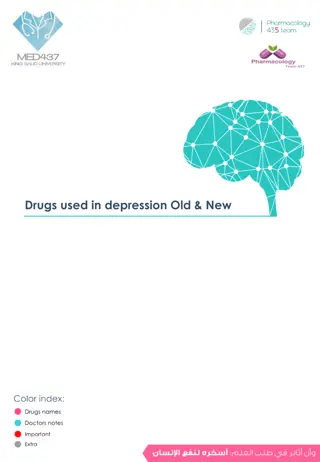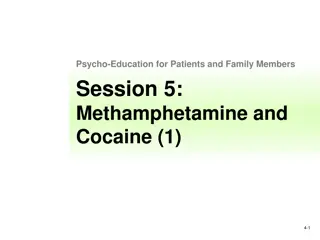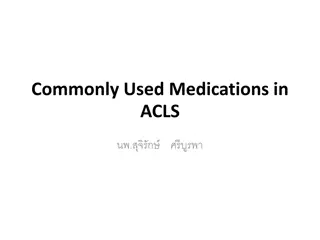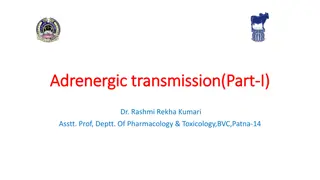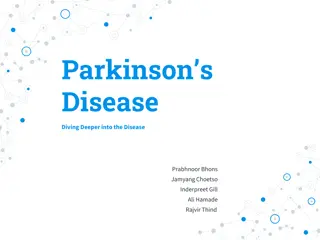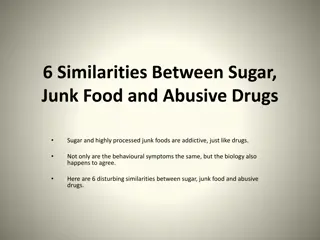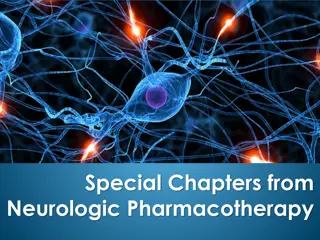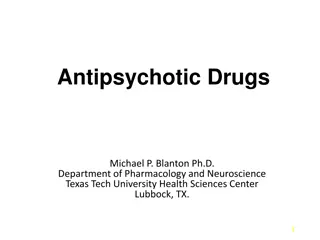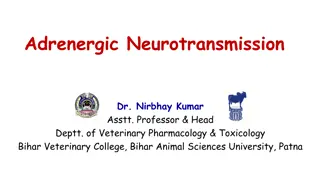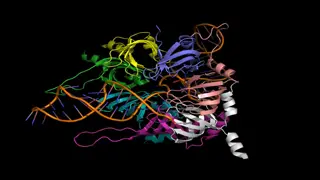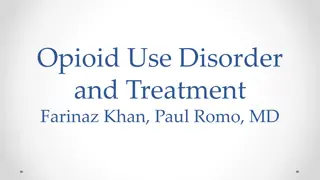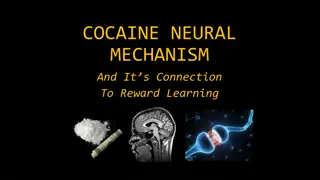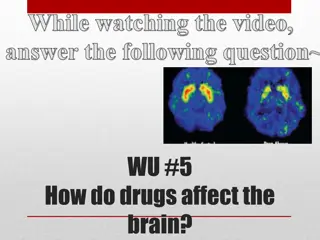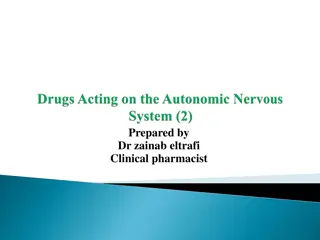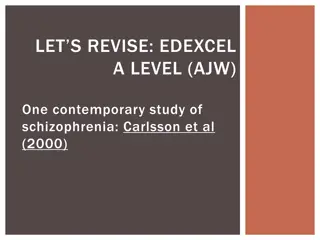Neurologic Disorder
Structural divisions of the central and peripheral nervous systems, learn about neuron anatomy, the neuromuscular junction, and the role of neurotransmitters. Includes information on Acetylcholine, Norepinephrine, Dopamine, and Serotonin.
0 views • 24 slides
Understanding Antipsychotic Drugs and Their Classification
Antipsychotic drugs, also known as neuroleptics, are essential in treating schizophrenia and other psychotic disorders. They work by targeting dopamine and serotonin receptors in the brain, managing symptoms like hallucinations and delusions. Learn about the dopamine-serotonin hypothesis of schizoph
9 views • 21 slides
Understanding Depression and Its Treatment: Old vs. New Drugs
Depression, a common mood disorder affecting millions, is characterized by neurochemical imbalances. Various forms of depression exist, ranging from mild to severe and even psychotic. Symptoms include loss of interest, feelings of worthlessness, and recurrent thoughts of death. Treatment involves in
0 views • 28 slides
Understanding the Effects of Methamphetamine and Cocaine
This session covers the differences between cocaine and methamphetamine, focusing on their effects on the brain, particularly the role of dopamine. It explains how dopamine influences pleasure, motivation, and various responses in the body. Imbalance in dopamine levels can lead to a range of symptom
0 views • 20 slides
Understanding the Effects of Methamphetamine and Cocaine
Explore the key differences between cocaine and methamphetamine, how dopamine plays a crucial role in the brain affecting movement, thinking, and pleasure responses. Learn about the effects of dopamine imbalance and the impact of stimulant drugs on dopamine levels over time. Understand the addiction
0 views • 20 slides
The Power of Music in Second Language Acquisition
Enhancing second language acquisition through music offers numerous benefits such as improved pronunciation, vocabulary expansion, cultural understanding, and enhanced motivation. Music activates brain regions vital for learning and memory, releases dopamine to improve mood, and provides a portable
0 views • 27 slides
Commonly Used Medications in ACLS: Adenosine, Amiodarone, Atropine, Dopamine, Epinephrine
Adenosine is used for SVT, Amiodarone for VT/VF, Atropine for bradycardia, Dopamine for shock, and Epinephrine for cardiac arrest. Each medication has specific dosages and side effects. These drugs play crucial roles in advanced cardiac life support scenarios.
8 views • 16 slides
Understanding Adrenergic Transmission and Catecholamine Synthesis
Adrenergic transmission involves the release of neurotransmitters such as norepinephrine, dopamine, and epinephrine at synapses or neuroeffector junctions. These neurotransmitters, known as catecholamines, play crucial roles in transmitting impulses in the sympathetic nervous system and central nerv
0 views • 14 slides
Understanding Parkinson's Disease: Diving Deeper into the Neurodegenerative Disorder
Parkinson's disease is a neurodegenerative disorder that impacts dopamine levels in the brain. The history, epidemiology, causes, and pathophysiology of the disease are explored, shedding light on its significant impact on the nervous system. Genetic and environmental factors play a role in the deve
0 views • 25 slides
Comprehensive Overview of Propofol: Mechanism, History, and Pharmacokinetics
Propofol is a widely used IV hypnotic with a unique mechanism of action involving GABA receptors and dopamine modulation. Its history, from initial anaphylactic reactions to current emulsion formulations, is intriguing. Understanding its pharmacokinetics, including metabolism in the liver and kidney
0 views • 59 slides
Disturbing Similarities Between Sugar, Junk Food, and Abusive Drugs
Sugar and highly processed junk foods share disturbing similarities with abusive drugs, including dopamine flooding in the brain, leading to powerful cravings, activating similar brain areas, and building tolerance to rewarding effects. These similarities highlight the addictive nature of these food
0 views • 8 slides
Pharmacotherapy Overview of Parkinson's Disease and Related Disorders
Overview of pharmacological treatment options for Parkinson's disease and related conditions like choreatic dyskinesias, spastic disorders, and myasthenia gravis. Describes the degenerative process of Parkinson's disease, its symptoms, and the pharmacological interventions targeting dopamine deficit
0 views • 26 slides
Overview of Antipsychotic Drugs and Treatment for Psychotic Disorders
Antipsychotic drugs play a vital role in managing psychotic disorders by targeting dopamine and serotonin receptors. This overview covers the mechanism of action, classification (typical vs. atypical), side effects, and therapeutic efficacy of antipsychotic medications. It also delves into the mood-
0 views • 31 slides
Understanding Adrenergic Neurotransmission in Veterinary Pharmacology
Adrenergic neurotransmission, mediated by norepinephrine, dopamine, and epinephrine, plays a crucial role in various physiological processes. This process involves synthesis, storage, release, and termination of catecholamines like norepinephrine and epinephrine. The intricate mechanisms of neurotra
0 views • 12 slides
Understanding Splice Sites and Splicing Elements in the Inhibitory Dopamine Receptor Gene (D2)
In this project, the focus is on identifying splice sites relevant to the inhibitory dopamine receptor gene (D2). The problem involves finding splicing elements within a specific range of known splice sites in the gene. The data provided includes the D2 gene entry in FASTA format, a database of spli
0 views • 13 slides
Understanding Opioid Use Disorder and Treatment Options
This presentation delves into the complexities of Opioid Use Disorder (OUD), discussing its impact on the neuroendocrine system, treatment options, including Medications for Opioid Use Disorder (MOUD), and special populations. The objective is to connect endogenous mechanisms to clinical observation
0 views • 52 slides
Understanding the Effects of Methamphetamine and Cocaine
Explore the key differences between cocaine and methamphetamine, the role of dopamine in the brain, the effects of dopamine imbalance, and the impact of stimulant drugs like shabu/cocaine on dopamine levels over time. Learn about the craving, use, depression, and addiction cycle associated with thes
0 views • 20 slides
Understanding Cocaine's Neural Mechanism and Reward Learning Circuit
Cocaine affects the brain's reward circuit by blocking dopamine transporters, leading users to associate the drug with a rewarding feeling. Prolonged use can result in internalization of dopamine receptors. By hijacking reward-learning mechanisms, cocaine becomes one of the most harmful and addictiv
0 views • 13 slides
The Impact of Drug Use on Behavior and Health
Drugs affect the brain by increasing the flow of dopamine, which leads to the formation of habits and cravings. This overwhelms the brain's addiction hotspot, rewiring it to desire more drugs. Different drugs interact in various ways to cause addiction. Beyond the physiological effects, substance ab
0 views • 12 slides
Treatment Options for Cardiogenic Shock: Pharmaceutical and Mechanical Support
This article discusses pharmaceutical treatment options for cardiogenic shock, including milrinone, dobutamine, and dopamine. It also explores criteria for escalating treatment to mechanical support in cases of severe shock. The comparison between milrinone and dobutamine in supporting patients awai
0 views • 19 slides
Understanding Adrenergic Agonists and Their Classification
Sympathomimetic amines like epinephrine, norepinephrine, isoproterenol, and dopamine are catecholamines with high potency but poor CNS penetration. Noncatecholamines like phenylephrine and ephedrine have longer half-lives. Learn about direct-acting, indirect-acting, and mixed-action adrenergic agoni
0 views • 25 slides
Insights into Nicotine Effects and Smoking Cessation Medications
Nicotine acts as an agonist at nicotinic acetylcholine receptors in the brain, impacting dopamine release and opioid activity. It has a short half-life and is metabolized by the liver. Understanding its sedative effects at high doses and the development of tolerance and withdrawal symptoms is crucia
0 views • 29 slides
Understanding Schizophrenia: Insights from Carlsson et al.'s 2000 Study
Carlsson et al.'s 2000 study on schizophrenia explores the dopamine hypothesis, highlighting the interplay of neurotransmitters like glutamate, serotonin, and GABA. They suggest future drug treatments for schizophrenia, emphasizing the need to consider neurotransmitter interactions beyond dopamine.
0 views • 17 slides
Understanding Gamification in Education Through Gaming Principles
Delve into the world of gamification in education with a focus on gaming principles used to enhance learning experiences. Explore the concept of gamification, its benefits, and why individuals are motivated to keep playing games. Discover the role of dopamine in gaming and ways to boost its levels t
0 views • 28 slides


